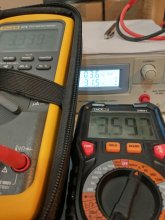@Dzl You've probably heard me talk many times about using off-the-shelf CC power supplies to charge cells. Lets step through each stage and I'll describe what's happening and why.
Three things you have to keep in mind:
1. A LFP cells internal resistance goes up as its charge state goes up. This is initially a minor contributor but it does have a noticible effect near the end of the charge cycle.
2. A constant current limiting power supply reduces its output voltage to control how many amps its putting out so it doesnt overamp itself and melt.
3. Amperage is governed by how much 'force' (voltage) is pushing and how much resistance there is inhibiting that flow of amperage. Loads aren't 'pushed' power, loads 'pull' power based on its resistance and how much voltage there is to move the amps along. You could have a power source capable of a million amps but a load is only going to pull what it pulls.
Stage 1
LFP cell is at 2.50V, power supply is set for 3.65V giving us a 1.15V difference to move amperage.
Cell is connected and amps begin to flow, there are a dozen or so millohms total resistance in cell, cables and connectors but not enough to prevent a huge flood of amperage - WAY more than the PS can handle. Power supply detects this overload and reduces its output voltage to 3.1ish volts (bringing down the voltage difference to .6v) to throttle back the amount of amperage the cell is pulling from it to what the PS can handle.
Stage 2
As the cell voltage rises the voltage differential goes down and so the resulting amperage goes down, the PS knowing its supposed to be putting out 3.65v (but it's not because it's in a overload condition) raises its voltage up (thus allowing more amps) until it hits its overload limits again with the net effect that the amperage stays the
same but the PS voltage raises with the cell voltage keeping the original voltage differential it had to keep from overamping. -------This is the Constant Current stage of charging.
Stage 3
The cell voltage has raised enough that the power supply can now output the 3.65v it was set for without overamping. It does a little happy dance. The cell voltage keeps rising thus the
voltage differential starts decreasing which means there isnt as much voltage available to move the amps along so amperage starts dropping ----------This is the Constant Voltage stage of charging
Note: If you were really in a hurry you could raise the set voltage some more to maintain the voltage differential you've had all along to keep the amperage flowing at the maximum rate. This is what a "quick/smart" charger does but it's not necessary, it just shaves off overall charging time.
Stage 4
Amperage continues to drop and the voltage differential gets lower and lower. Because the voltage differential is so low now the resistance of the cells (which has gone up), cable, and connectors is inhibiting amperage flow to a greater and greater degree since the ratio of voltage to resistance is tipping in favor of the resistance. Eventually amperage drops to just an amp or less, getting less and less as time goes on. Amperage changes are fairly slow at this point but eventually amperage goes to almost nothing as resistance triumphs over the very little differential voltage available. --------- This can be considered the Absorption stage of charging
Stage 5
Amps leak from positive to neg inside the cell, microscopically dropping the cell voltage to allow more amperage in. Big player in lead acid batteries but almost zero in a LFP cell. ---------This is the Float stage of charging.
You REALLY don't want to do this to a LFP cell, the continued applied voltage is still slowly moving lithium around inside the cell and plating lithium metal to places you don't want it to be and reducing the anode (cathode? can't remember) surface are and permanently reducing the cell capacity.
Hope this made sense.









